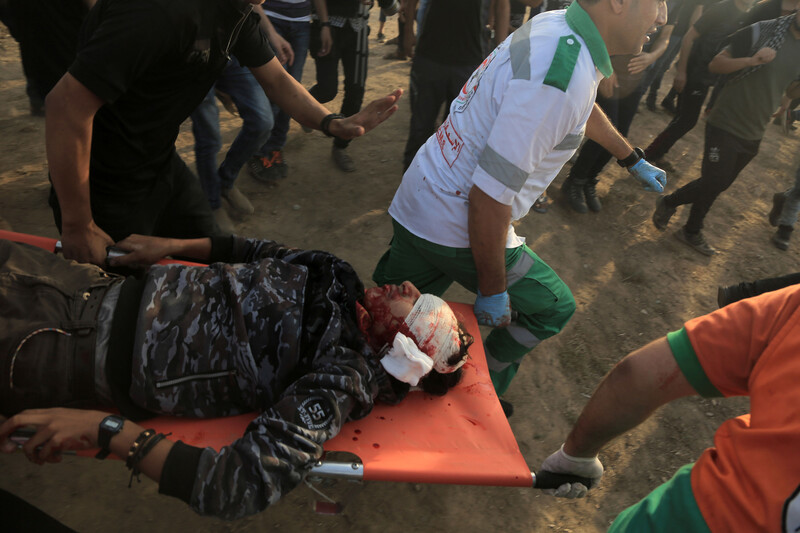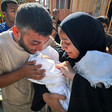Rights and Accountability 5 June 2019

Palestinian medics evacuate a critically injured protester during Great March of Return demonstrations in October 2018.
ActiveStillsThere were nearly 7,000 gunshot wounds among Gaza’s population of two million in the duration of a year.
Many of those injured have extensive and in some cases irreversible damage to their bones, neurovascular structures and soft tissue.
Among them, hundreds face amputations if they cannot access specialized tertiary treatment for their catastrophic wounds.
Three health workers have been killed and more than 700 others injured.
Thousands of elective surgeries were postponed as a health system already in crisis took in wave after wave of emergency casualties.
Cases of gender-based violence seen by service providers doubled as families struggled to cope with additional economic pressures and trauma.
These disturbing facts come from the World Health Organization’s review of trauma data related to the Great March of Return protests in Gaza which began in March 2018.
Sanitized
The data provided by WHO make for harrowing reading. But the report sanitizes the fact that this body-breaking and traumatizing violence is by Israeli policy and design.
Any effective treatment must correctly diagnose the cause and not just the symptoms.
In the year following the launch of the Great March of Return, more than 28,000 Palestinians in Gaza were injured and 277 killed, including 52 children, most of them slain during unarmed, mass protests along Gaza’s eastern and northern perimeter.
Despite the civilian nature of the protests, as was affirmed by a panel of UN investigators, WHO says the deaths and injuries happened “as a result of clashes with Israeli security forces.”
That is a gross mischaracterization of Israel’s use of force against peaceful and unarmed protesters, officially sanctioned by shoot-to-kill or maim orders against civilians who pose no plausible threat, even when they are children.
The killing of some 60 Palestinians during protests on 14 May 2018 was a massacre.
That day, Israeli occupation forces shot almost one person per minute during protests east of Gaza City between 9:30 in the morning and 5:30 in the afternoon, according to the UN commission of inquiry.
Some protesters attempted to breach the boundary fence, or threw stones or spent gas grenades fired by Israel back in the soldiers’ direction. But these were not confrontations between two armed groups as the use of “clashes” by WHO would suggest.
Doctors who treated those wounded that day said, as summarized in the UN commission report, “the injuries resembled those that would typically be seen during a war.”
Hospital doctors told investigators that “one horrific injury after another” arrived to their facilities, the patients presenting massive open wounds to their lower limbs, their “skin and underlying tissue … blown out with the force of the bullet.”
In their report, the UN investigators state that during the months of protests, nearly 1,600 people “were wounded by bullet or bone shrapnel that resulted from ricochets, bullet fragmentation and shots going through one body into another – clearly illustrating the danger of firing high-velocity live ammunition into a crowd of demonstrators.”
The staggering number of casualties is not “a result of clashes with Israeli security forces,” it’s the illegal use of lethal force against unprotected persons by an occupying power that desires the full capitulation of the population under its control.
“Serious human rights violations were committed which may amount to crimes against humanity,” the UN investigators say.
12 years of siege
WHO’s report does note that the protests take place in the context of a 12-year siege on Gaza, yet doesn’t explicitly state that the blockade is imposed by Israel.
Gaza’s health system was “already under-resourced and chronically challenged,” WHO states. Half of all medicines in Gaza had reached zero stock – less than a one-month supply – during the first month of Great March of Return protests.
A bitter political impasse among the Palestinian political leadership, resulting in staff at government-run hospitals receiving only a fraction of their salaries, has also “reduced the capacity of local institutions in Gaza to deliver basic services.”
“In 2018 alone, 84 doctors left Gaza,” WHO states.
And despite all this, as the report notes, thousands of volunteer medics in Gaza have kept the health system resilient and have saved lives.
Only two patients out of nearly 6,000 who were wounded by high-velocity bullets to the limbs during the protests bled to death, because of the presence of trained community volunteers.
A trauma referral pathway, from first-aid at the point of injury to hospital and postoperative and rehabilitative care, saved hundreds of lives, according to WHO.
Three life-saving medics, two of them volunteers, were amongst those killed during the protests.
Yet Israel’s responsibility for their deaths is obscured in WHO’s report.
WHO states that “there was a surge in violent incidents involving health care” during the year of protests, with 446 incidents in Gaza in 2018 versus 24 reported the previous year.
In addition to the health workers killed, 730 were injured and more than 100 ambulances and other health vehicles were damaged.
But the report doesn’t identify the party responsible: Israel.
Contrast this with the unequivocal findings of the UN investigators, who state:
“Based on numerous interviews with victims and witnesses and corroboration of video footage in a number of instances, the Commission found reasonable grounds to believe that Israeli snipers intentionally shot health workers, despite seeing that they were clearly marked as such.”
Like the deaths and injuries of protesters, the killing and maiming of medical workers is a direct result of Israel’s open fire orders – not the “result of clashes.”






Comments
I live for the day when
Permalink Saja replied on
I live for the day when Israel is actually held accountable for its actions. However, thank you for pointing out the WHO's bull and hypocrisy.
WHO sanitizes Israeli responsibility for Gaza killings
Permalink Pat Mc Ginley replied on
No surprise when we look at the Wikipedia list of WHO funders and 'partners' i.e. the political controllers of the WHO: "The largest annual assessed contributions from member states came from the United States ($110 million), Japan ($58 million), Germany ($37 million), United Kingdom ($31 million) and France ($31 million) Partners include the Bill and Melinda Gates Foundation and the Rockefeller Foundation. The WHO along with the World Bank constitute the core team responsible for administering the International Health Partnership."